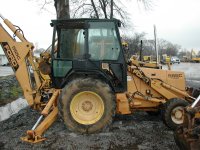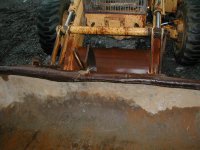rexcramer said:On this type of machine the newer the machine the more expensive the parts are in my experience.
A new hydraulic pump on my machine cost $300. A new one on a 580K costs over $1000 because it has an "improved and refined" pump, which has the power steering and hydraulics combined in one pump.
I can do the brakes on my machine myself for less than $200, on a 580K and newer the same job costs way over $1000 because the "improved and refined" wet disk brakes are part of the transaxle and the whole unit has to be removed just to access the brakes.
If my transmission completely fails on me I can have the entire unit rebuilt for about $2500. On a 580K or newer the "improved and refined" transmission is much more labor intensive to repair, and costs between $5000 and $7000 for a rebuild.
My machine gets the job done just as well as a newer unit, maybe a hair slower, but is much more serviceable and affordable to a guy on a budget. These refinements are great when the machine is new. They are a PIA when the machine gets some hours on it.
As far as parts availability, these machine last so long the major manufacturers do a very good job of providing parts for machines that are 30 years old and older.
Except the older, Phase I 580K is the same as the C with external dry brakes and much cheaper to fix. Don't know about the hydraulic pump though.
On a Case, I would very definitely get the older machine over a newer machine for the above reasons. The primary advantage in newer is that Case gradually reinforced the high stress points more and more over the years, but the C will work just fine if not overly abused. To see what I mean, check the steel gussets on the FEL for different models starting with the C up throught the M. The reinforcing gets larger and more massive with each newer model.
Also, the backhoe was weak point on the earlier hoes, but starting with the E (I think this is correct) Case switched from a welded steel boom (or whatever you call the 1st section) with two outside mounted hydraulic cylinders to a cast steel boom with a single center mounted cylinder. They also changed and reinforced the welded steel portion of the boom where the bucket attaches, as this is a frequent area needing repairs if the machine is used hard. Also, Case switched to Cummins engines starting with either the D or E models, though I haven't heard bad things about the Case engine. Not sure why they quit using their own engines.
But all you need to do when checking an older unit is to look for welds on the FEL frame, especially at the front crossover bracket, and on the backhoe at the stress points, and especially at the end of the boom where the bucket attaches. It is very common for most TLBs to have a few welds, but what you don't want is to see lots of welds upon welds with new cracks through the welds.
In your price range, and really in any price range, trust me, you will be miles and miles ahead buying an older well kept machine instead of a newer beatup machine.





